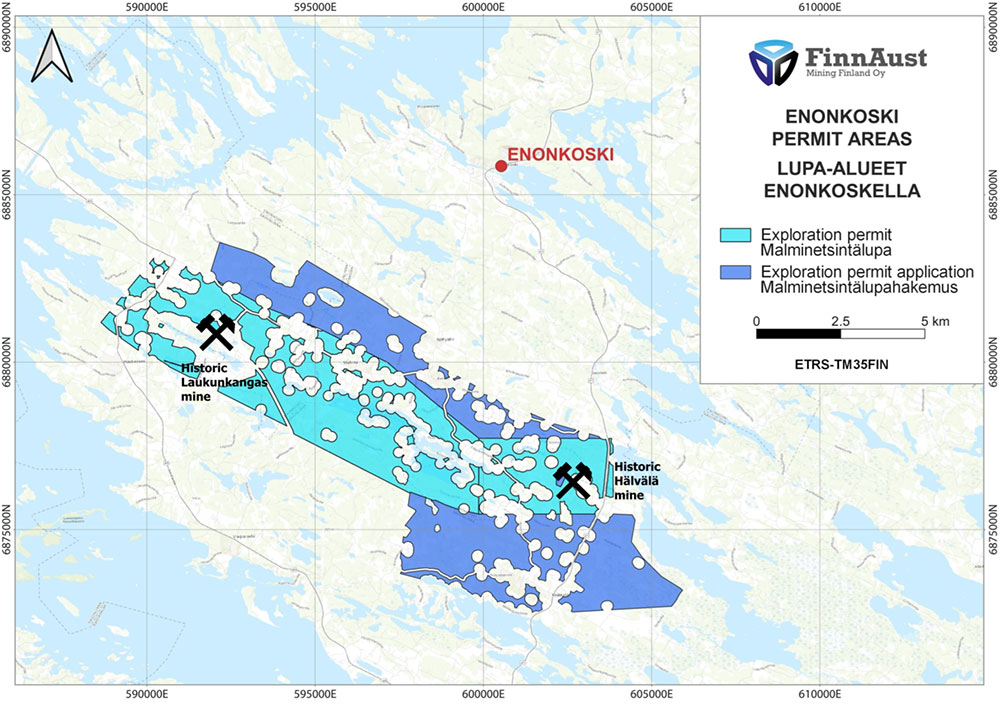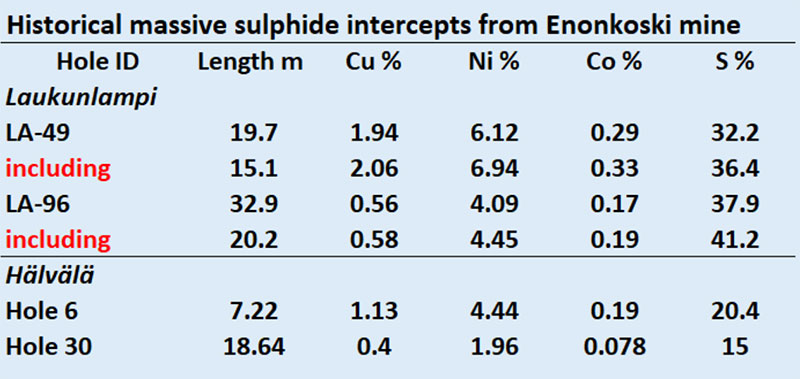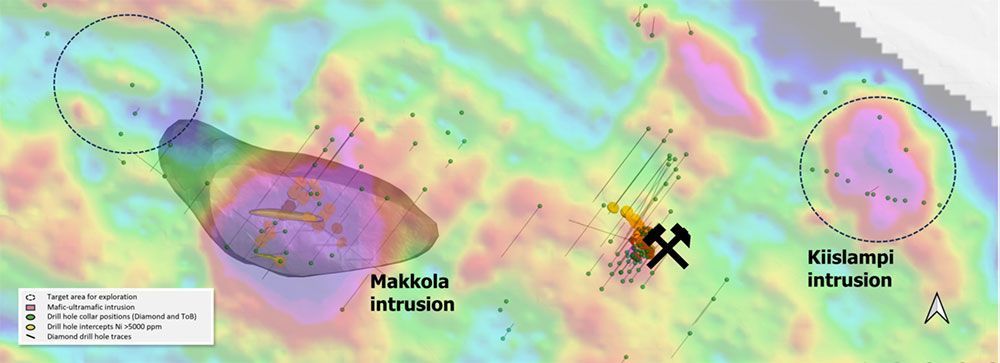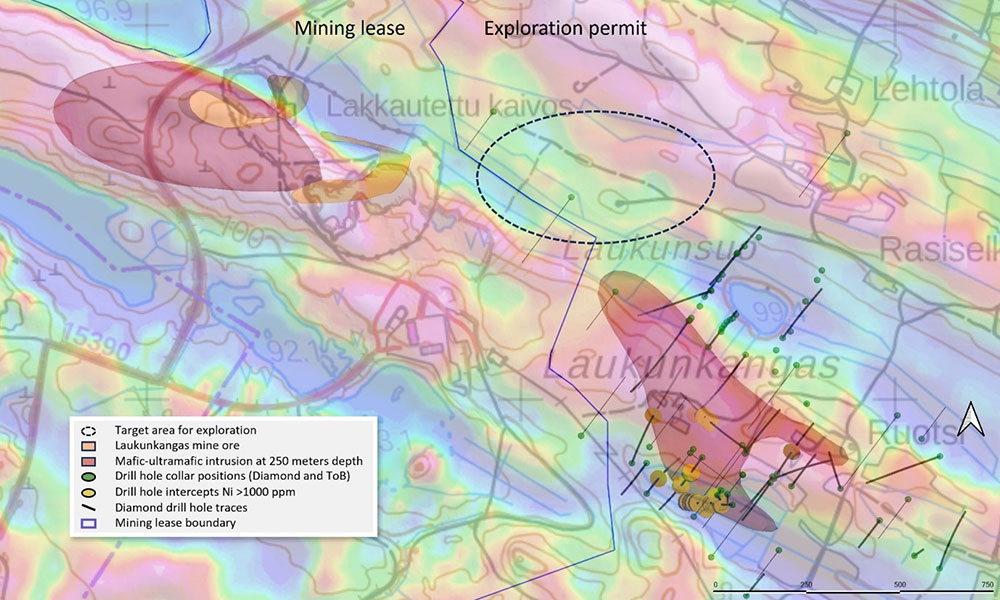Enonkoski Nickel-Copper Project
Mafic-ultramafic-hosted magmatic nickel-copper-cobalt sulphide targets on a large-scale belt hosting two historical mines
80 Mile is exploring at Enonkoski for high-tenor orthomagmatic nickel-copper-cobalt (Ni-Cu-Co) sulphide deposits hosted in Svecofennian (c. 1.88 Ga) mafic-ultramafic intrusions. 80 Mile’s 100% owned subsidiary, FinnAust Mining Finland Oy, has been exploring on the Enonkoski Belt since 2012, but the belt has been known for its ore potential since the 1970s when Ni-Cu-Co mineralised intrusions were first discovered in the area: the Hälvälä deposit in 1971 and the Laukunkangas deposit in 1980.
Mining started first at Laukunkangas in 1985, and three years later at Hälvälä. Prior to commencement of mining, the Ore Reserves totalled 9.4 million tonnes grading 0.67% nickel, 0.18% copper and 0.029% cobalt, and Measured and Indicated Resources totalled 3.1 million tonnes grading 0.34% nickel, 0.11% copper and 0.019% cobalt. During ten years in operation the two mines produced 7.35 million tonnes of ore grading 0.83% nickel and 0.23% copper.
Since acquiring the project, FinnAust has carried out several fieldwork campaigns including, airborne helicopter and drone geophysical surveys, ground and down-hole geophysical surveys, top-of-bedrock (ToB) drilling, diamond drilling and geological mapping and outcrop sampling of the area. This has resulted in the discovery of several zones of “droplet-ore” similar to that which surrounds the high-grade massive sulphide ore at the former Laukunkangas mine.

Figure 1. Enonkoski Ni-Cu-Co Project permit areas, as of October 2023.

Table 1. Selected historical intercepts from the former Laukunkangas and Hälvälä Ni-Cu-Co mines.
Recent Exploration Activities:
FinnAust’s recent work at Enonkoski has been carried out under a Joint Venture (JV) Agreement with Rio Tinto. The JV Agreement ended in July 2023 and 80 Mile retains 100% ownership of the Project (through FinnAust Mining Finland Oy) along with all data, samples and drill cores collected during the JV. Total exploration expenditure by Rio Tinto on the Enonkoski belt during the JV totalled US$ 4.65 million. This included:
- 9,667m of diamond drilling for a total of 29 new drill holes and extensions of 2 historic drill holes, focussed on the Laukunlampi, Laukunsuo, Muhelampi and Tevanjoki near-mine target areas surrounding the former Laukunkangas Ni-Cu-Co Mine.
- Re-logging and sampling historical drill cores drilled by Outokumpu Oy, the Geological Survey of Finland and FinnAust, totalling 65 drill holes for >16,750 m, including comprehensive lithogeochemistry of selected intervals, totalling >1000 drill-core samples; specific gravity, magnetic susceptibility, conductivity, and portable x-ray fluorescence (pXRF) measurements; and detailed core photography.
- 160 ToB diamond drill holes for a total of 1,633.5 m of drilling over 7 targets.
- 5 line-kilometres of ground magnetics over 2 targets.
- 2018 line-km of three component (3C) UAV magnetics surveys, covering 50.2 square kilometres.
- A 747 station ground gravity survey, covering a 2 square kilometres area at the Makkola-Hälvälä target.
- Downhole electromagnetic (DHEM) surveys were completed on a total of more than 50 drillholes for a total of >22,000 metres including measurements of both historic and new drill holes with several loop configurations.
- 5D airborne electromagnetic inversion processing completed on 1,055 line-km of HeliTEM data by Intrepid Geophysics.
- Geological, geophysical and geochemical modelling (Leapfrog Geo/Edge, ioGAS).
- Lithogeochemical and petrological studies by consultant geologist, Dr Hannu Makkonen.
- Prospectivity analysis and ranking of all known intrusions.
- Geological mapping and outcrop sampling.
- LIBS (Laser Induced Breakdown Spectroscopy) scanning of selected drill core.

Figure 2. Enonkoski Ni-Cu-Co Project showing confirmed and interpreted mafic-ultramafic intrusions (defined by drilling and geophysics). Diamond and Top-of-Bedrock drilling completed under the JV with Rio Tinto is shown, along with the coverage of recent airborne and ground geophysical surveys.
Continued Exploration Plans:
Most of the activities to date have focused on near-mine targets in the vicinity of the former Laukunkangas mine, but early-stage exploration work has also been conducted at several regional targets on the belt, generating multiple high priority, drill ready targets as well as new targets for ToB drilling.
High priority target – Makkola
- Confirmed mineralised mafic-ultramafic intrusion.
- Close to historical Hälvälä mine
- Disseminated and thin massive Ni-Cu sulphides intersected in historic drilling – no recent diamond drilling conducted.
- Extensions of known mineralisation untested by drilling.
- Geophysical modelling indicates that the intrusion continues towards northwest under thick till cover.
- Continued exploration plans:
- Detailed ground magnetic and/or electromagnetic surveys.
- Phase 1 diamond drilling -shallow drilling testing the possible extensions of the known mineralisation.
- Phase 2 diamond drilling -follow up drilling further towards the northwest.
High priority target – Kiislampi
- Mafic-ultramafic Intrusion confirmed by shallow diamond and ToB drilling
- 3D inversion and modelling of ground gravity data has identified a gravity anomaly at shallow depth
- Thin massive Ni-Cu-Co sulphide veins intersected in historic drilling
- Close to historical Hälvälä mine
- Continued exploration plans:
- Diamond drilling testing the gravity inversion model
- Detailed ground magnetic and electromagnetic surveys

Figure 3. Makkola and Kiislampi exploration targets at the Enonkoski Ni-Cu-Co Project. Location of the former Hälvälä Ni-Cu-Co mine is also indicated.
High priority target – Laukunlampi
- Semi-massive, droplet and wide zones of disseminated Ni-Cu-Co sulphides have been intersected in several recent drill holes by FinnAust.
- Mineralisation is associated with vari-textured pyroxenite
- The Laukunlampi intrusion remains open in northwest towards the historic Laukunkangas mine – this area is covered by thick overburden.
- pXRF measurements conducted on the large sulphide droplets/blebs show up to 11% Ni and 6% Cu, demonstrating the very high Ni-Cu tenor of the sulphides in this intrusion
- Continued exploration plans:
- Drill testing the possible extensions of the Laukunlampi intrusion and confirmed mineralisation north-west towards the historic Laukunkangas mine
- Modern ground gravity survey, possibly detailed ground magnetics.

Figure 4. Laukunlampi exploration target at the Enonkoski Ni-Cu-Co Project. Location of the former Laukunkangas Ni-Cu-Co mine is also indicated. FinnAust drill holes are indicated. Dashed circle indicates the area of interest to the northwest of the Laukunlampi intrusion where the intrusion remains open towards the former mine.

